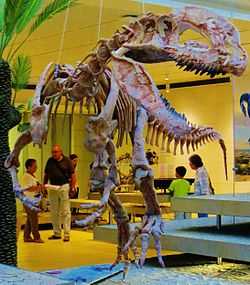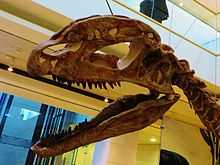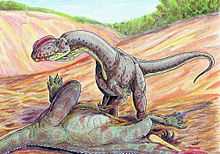Sinosaurus
| Sinosaurus Temporal range: Early Jurassic, 201–196Ma | |
|---|---|
 | |
| Mounted cast | |
| Scientific classification | |
| Kingdom: | Animalia |
| Phylum: | Chordata |
| Clade: | Dinosauria |
| Clade: | Theropoda |
| Family: | †Dilophosauridae |
| Genus: | †Sinosaurus Young, 1948 |
| Type species | |
| †Sinosaurus triassicus Young, 1948 | |
| Synonyms | |
| |
Sinosaurus (meaning "Chinese lizard") was a tetanuran theropod dinosaur which lived during the Early Jurassic Period. Its fossils were found in the Lufeng Formation, in Yunnan Province, China. It was a bipedal carnivore. There is currently insufficient information available to reliably estimate its dimensions.
Etymology
The composite term Sinosaurus comes from Sinae, the Latin word for the Chinese, and the Greek word sauros (σαυρος) meaning "lizard"; thus "Chinese lizard". The specific name, triassicus, refers to the Triassic, the period that the fossils were originally thought to date from. Sinosaurus was described and named by Chung Chien Young, who is known as the 'Father of Chinese Vertebrate Paleontology', in 1948.[1]
Description
.jpg)
The holotype, IVPP V34, was found in the Lower Lufeng Formation, and consists of two maxillary (upper jaw) fragments, four maxillary teeth, and a lower jaw fragment with three teeth. The teeth are laterally compressed, and feature fine serrations both at their anterior and posterior edges. The teeth are also variable in size and are curved backwards. This material is too fragmentary to determine the length and weight of this dinosaur. Over the years, other fossils were referred to Sinosaurus, some of which were material that was shown to belong to two prosauropods[2][3]
Shaojin Hu (1993) assigned specimen KMV 8701 to Dilophosaurus sinensis.[4] In 2013, a study by Currie et al., confirmed that D. sinensis was the same animal as Sinosaurus triassicus.[5] Specimen KMV 8701 consists of a skull (measuring 525 mm), a lower jaw, nine cervical, fifteen dorsal, four sacral and thirty-six caudal vertebrae, cervical ribs, chevrons, both scapulae and both coracoids, a distal clavicle, a humerus, an ulna and radius, metacarpals, an ilium, pubis and ischium, a femur (measuring 587 mm), a tibia and fibula, an astragalus, a calcaneum, distal tarsal IV, metatarsus, and a pes.
Over the years, paleontologists referred additional specimens to D. sinensis which are now assigned to Sinosaurus. Dong (2003) referred specimen LDM-LCA10 which consists of a skull and an incomplete skeleton. In 2012, Xing referred two individuals, ZLJ0003 which consists of a partial skull and an incomplete skeleton, and ZLJT01 which is a juvenile individual that consists of a premaxillary fragment, an incomplete maxilla, a maxillary fragment, a lacrimal, both frontals, both parietals, an incomplete braincase, an incomplete dentary, an atlantal intercentrum, two dorsal rib fragments, and a partial proximal caudal neural arch.
Classification

Originally thought to be a coelophysoid related to Dilophosaurus, Oliver Rauhut in 2003 showed Sinosaurus to be a more advanced theropod, related to Cryolophosaurus and "Dilophosaurus" sinensis.[6] In 2013, in an unpublished work, Carano agreed that Sinosaurus is a theropod.[7]
Dilophosaurus sinensis was shown to be a junior synonym of Sinosaurus in 2013.[8] It is possibly closer to the Antarctic theropod Cryolophosaurus, based on the fact that the anterior end of the jugal does not participate in the internal antorbital fenestra and that the maxillary tooth row is completely in front of the eye socket. D. sinensis was exhibited in 1998 at Dinofest in Philadelphia.[9] Although the skull of D. sinensis sports large nasolacrimal crests superficially like those reconstructed in D. wetherilli, features elsewhere in the skeleton suggest it is closer to tetanuran theropods.[10] Rauhut (2003) regarded D. sinensis as a basal tetanuran most closely related to Sinosaurus and Cryolophosaurus.[11] Lamanna et al. (1998b) examined the material ascribed to D. sinensis and found it to be synonymous with Sinosaurus triassicus.[12] This cladistic finding was confirmed in 2013 by Currie et al.[5][8]
The Lufeng Dinosaurian Museum discovered a new specimen of Sinosaurus (ZLJT01) in 2007 from the Lufeng Basin. It consists of an incomplete skull and other postcranial fragments. Phylogenetic analysis of this specimen, demonstrates that Sinosaurus is a more derived theropod, and is not the most basal dilophosaurid, as held by Smith et al.[13]
Distinguishing anatomical features
A diagnosis is a statement of the anatomical features of an organism (or group) that collectively distinguish it from all other organisms. Some, but not all, of the features in a diagnosis are also autapomorphies. An autapomorphy is a distinctive anatomical feature that is unique to a given organism or group. According to Carrano et al. (2012) D. sinensis, now considered to be the same as Sinosaurus triassicus, can be distinguished based on the fact that a vertical groove is present on the lateral premaxilla adjacent to contact with the maxilla.
Paleobiology

Paleopathology
A study by Ling et al. (2013) examined the effect of the traumatic loss of teeth on the dental alveolus (the socket in the jaw where the roots of teeth are held) in dinosaurs. Sinosaurus is the first dinosaur where remodeling of the alveolus in the jaw was observed.[13] The authors concluded that this finding "contributes to mounting evidence suggesting theropods were highly resilient to a broad spectrum of traumas and diseases."[13]
Paleoecology
Provenance and Occurrence

The type specimen of Sinosaurus triassicus IVPP V34 was recovered in the Zhangjiawa Member of the Lufeng Formation, in Yunnan, China. These remains were discovered at the Dark Red Beds that were deposited during the Sinemurian stage of the Jurassic period, approximately 196-183 million years ago. Several other discoveries referred to Sinosaurus were made in the Zhangjiawa Member: specimens IVPP V97 (postcrania), IVPP V36 (teeth), IVPP 37 (teeth), IVPP V88 (ilium), IVPP V35 (teeth and postcranial bones), IVPP V100 and IVPP V48 (teeth and postcranial bones) discovered in 1938 by M. Bien & C.C. Young,[14] FMNH CUP 2001-2003 discovered by E. Oehler and Hu.[15] Specimens FMNH CUP 2097, FMNH CUP 2098, FMNH CUP 2004, FMNH CUP 2005 were discovered in 1948 by M. Bien & C.C. Young at Zhangjiawa Member, as well.[16]
Specimen IVPP V504, referred to Sinosaurus, a maxilla with four teeth, was collected by Lee in the 1940s, in the Dull Purplish Beds of Shawan Member of the Lufeng Formation, that were deposited during the Hettangian stage of the Jurassic period, approximately 201-199 million years ago. Several other discoveries were made in the Shawan Member: parts of two skeletons attributed to Sinosaurus were discovered by Sou in 1956,[17] specimen IVPP V279 (tooth) was discovered by C.C. Young in 1938, in dark red clayish sandstone, and specimen IVPP V381 (several teeth) was discovered by C.C. Young, in blue mudstone.[14] The D. sinensis remains, KMV 8701, a nearly complete skeleton, now referred to Sinosaurus, were recovered in the Shawan Member of Lufeng Formation. This material was discovered in 1987 in the Dull Purplish Beds that were deposited during the Hettangian stage of the Early Jurassic, approximately 201-199 million years ago.
Fauna and Habitat
The Lufeng Formation has yielded the remains of the possible therizinosaur Eshanosaurus and the possible theropod Lukousaurus. Sinosaurus shared its paleoenvironment with therapsids like Morganucodon, Oligokyphus and Bienotherium, archosaurs like Pachysuchus, diapsids like Strigosuchus, crocodylomorphs like Platyognathus and Microchampsa, the early mammal Hadrocodium, and other early reptiles. Other dinosaurs discovered included indeterminate remains of sauropods, and the early armored dinosaurs Bienosaurus and Tatisaurus, as well as the prosauropods Gyposaurus, Lufengosaurus, Jingshanosaurus, and Yunnanosaurus. Zhang and Young (1995) noted that Sinosaurus preyed upon another dinosaur they described, Jingshanosaurus.[18]
References
- ↑ Young, C.C., 1948, "On two new saurischians from Lufeng, Yunnan", Bulletin of the Geological Society of China, 28: 75-90
- ↑ Walker, A. D., 1964, Triassic Reptiles from the Elgin area: Ornithosuchus and the origin of Carnosaurs: Philosophical Transactions of the Royal Society of London, series B, v. 248, p. 53-134.
- ↑ Young, C.C., 1951, "The Lufeng saurischian fauna in China", Palaeontologica Sinica, C (13): 1-96
- ↑ Irmis, Randall (2004-12-22). "First Report of Megapnosaurus from China" (PDF). PaleoBios 24 (3): 11–18.
- ↑ 5.0 5.1 Currie, Xing, Wu and Dong, in prep. Anatomy and relationships of Sinosaurus triassicus (“Dilophosaurus sinensis”) from the Lufeng Formation (Lower Jurassic) of Yunnan, China.
- ↑ Rauhut, O.W.M., 2003, The interrelationships and evolution of basal theropod dinosaurs. Special papers in palaeontology 69. The Palaeontological Association pp 215
- ↑ M. T. Carrano. 2013. Taxonomic opinions on the Dinosauria.
- ↑ 8.0 8.1 Xing, L.; Bell, P. R.; Rothschild, B. M.; Ran, H.; Zhang, J.; Dong, Z.; Zhang, W.; Currie, P. J. (2013). "Tooth loss and alveolar remodeling in Sinosaurus triassicus (Dinosauria: Theropoda) from the Lower Jurassic strata of the Lufeng Basin, China". Chinese Science Bulletin. doi:10.1007/s11434-013-5765-7.
- ↑ Glut, D. F. (1999). Dinosaurs, the Encyclopedia, Supplement 1: McFarland & Company, Inc., 442pp.
- ↑ Tykoski, R.S. & Rowe, T. (2004). "Ceratosauria". In: Weishampel, D.B., Dodson, P., & Osmolska, H. (Eds.) The Dinosauria (2nd edition). Berkeley: University of California Press. Pp. 47–70 ISBN 0-520-24209-2
- ↑ Rauhut, O.W.M. (2003). The interrelationships and evolution of basal theropod dinosaurs. Special papers in palaeontology 69. The Paleontological Association, pp 215.
- ↑ Lamanna, M. C., Holtz, T. R. Jr, and Dodson, P., 1998, A reassessment of the Chinese Theropod Dinosaur Dilophosaurus sinensis: Journal of Vertebrate Paleontology, Volume 18, Supplement to Number 3. Abstracts of papers. Fifty-eighth annual meeting, Society of Vertebrate Paleontology, Snowbird Ski and Summer Resort, Snowbird, Utah, September 30-October 3, 1998, p. 57a.
- ↑ 13.0 13.1 13.2 Xing L D, Bell P R, Rothschild B M, et al. Tooth loss and alveolar remodeling in Sinosaurus triassicus (Dinosauria: Theropoda) from the Lower Jurassic strata of the Lufeng Basin, China. Chin Sci Bull, doi: 10.1007/s11434-013-5765-7
- ↑ 14.0 14.1 M. N. Bien. 1940. Discovery of Triassic saurischian and primitive mammalian remains at Lufeng, Yunnan. Bulletin of the Geological Society of China 20(3/4):225-234
- ↑ D. J. Simmons. 1965. The non-therapsid reptiles of the Lufeng Basin, Yunnan, China. Fieldiana: Geology 15(1):1-93
- ↑ B. Patterson and E. C. Olson. 1961. A triconodont mammal from the Triassic of Yunnan. In G. Vandebroek (ed.), International Colloquium on the Evolution of Lower and Non Specialized Mammals. Koninklijke Vlaamse Academir voor Wetenschappen, Letteren en Schone Kunsten can Belgie 129-191
- ↑ C.-C. Young. 1966. On a new locality of the Lufengosaurus of Yunnan. Vertebrata PalAsiatica 10(1):64-67
- ↑ Y. Zhang, and Z. Yang. (1995). A new complete osteology of Prosauropoda in Lufeng Basin, Yunnan, China. Yunnan Publishing House of Science and Technology, Kunming, China 1-100. [Chinese]
External links
- Information on Sinosaurus and other early dinosaurs at Thescelosaurus